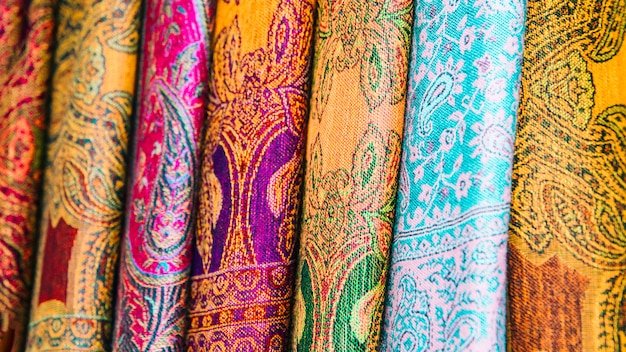
India’s rich history in textiles is renowned worldwide. From luxurious silks to breathable cottons, the country offers a diverse range of fabrics that reflect its cultural heritage and craftsmanship. In this guide, we explore India fabric types, their unique characteristics, and why they continue to captivate fashion enthusiasts and designers globally.
Why Indian Fabrics Are Globally Revered
Indian textiles are synonymous with quality, tradition, and artistry. The country’s diverse geography and culture have contributed to the development of a wide array of fabric types, each with its own story to tell. Whether it’s for traditional attire or modern fashion, Indian fabrics are versatile, durable, and timeless.
Popular India Fabric Types and Their Unique Features
1. Cotton: The Fabric of Comfort
India is one of the largest producers of cotton, known for its softness and breathability. Key highlights include:
- Ideal for hot and humid climates.
- Used in sarees, kurtas, and everyday wear.
- Variants like Khadi and Chikankari add a traditional touch.
2. Silk: The Queen of Textiles
Indian silk is celebrated for its luxurious feel and vibrant colors. Popular varieties include:
- Banarasi Silk: Known for intricate designs and gold or silver brocade work.
- Kanjeevaram Silk: Famous for its durability and traditional patterns.
- Tussar Silk: A raw silk variety with a unique texture.
3. Wool: A Winter Staple
Hailing from the colder regions of India, wool fabrics are warm and stylish.
- Pashmina Wool: Often referred to as “soft gold,” Pashmina is ultra-soft and lightweight.
- Angora Wool: Known for its silky texture and warmth.
4. Linen: The Eco-Friendly Option
Linen, though less common than cotton or silk, is gaining popularity for its sustainable production and durability.
- Perfect for casual and semi-formal wear.
- Lightweight and comfortable in warm weather.
5. Jute: The Golden Fiber
Jute, often called the “golden fiber,” is a robust and versatile fabric.
- Used in making bags, rugs, and home décor items.
- Eco-friendly and biodegradable.
Traditional Handwoven Fabrics of India
1. Khadi: A Symbol of Independence
Promoted by Mahatma Gandhi, Khadi represents self-reliance and simplicity.
- Hand-spun and handwoven.
- Popular for shirts, sarees, and home furnishings.
2. Bandhani: The Art of Tie-Dye
Originating from Gujarat and Rajasthan, Bandhani is known for its intricate tie-dye patterns.
- Vibrant colors and unique designs.
- Commonly used in sarees, dupattas, and turbans.
3. Ikat: Precision in Patterns
Ikat involves resist dyeing the yarn before weaving.
- Found in Andhra Pradesh and Odisha.
- Known for geometric and abstract designs.
4. Chanderi: Elegance Personified
Chanderi fabric from Madhya Pradesh is lightweight and sheer.
- Often adorned with zari work.
- Perfect for festive and formal occasions.
Read More: SaaS SEO RankStar: Your Ultimate Guide to Dominating Search Rankings
Modern Uses of Indian Fabrics
While traditional uses of Indian fabrics remain popular, modern designers are reimagining these textiles for contemporary fashion. From runway shows to global retail stores, India fabric types are being used in:
- Western outfits like dresses and jackets.
- Fusion wear that blends traditional and modern styles.
- Accessories such as scarves, bags, and footwear.
How to Choose the Right Fabric for Your Needs
When selecting an Indian fabric, consider the following factors:
- Occasion: Opt for silk or Chanderi for weddings and festivals, while cotton and linen are great for daily wear.
- Climate: Cotton and linen work well in summer, while wool and silk are ideal for winter.
- Durability: Khadi and jute offer robust options for both clothing and home décor.
Conclusion
The diversity of India fabric types is a testament to the country’s rich textile heritage and exceptional craftsmanship. Each fabric has its own charm, catering to a variety of preferences and needs. Whether you’re looking for the comfort of cotton, the luxury of silk, or the sustainability of linen, Indian fabrics have something to offer everyone.
Explore these timeless textiles and embrace the elegance they bring to your wardrobe and lifestyle.
FAQs
1. What is the most popular fabric in India?
Cotton is the most widely used fabric in India due to its comfort and versatility.
2. Why is silk so famous in India?
Indian silk is renowned for its luxurious texture, vibrant colors, and intricate designs.
3. Are Indian fabrics eco-friendly?
Yes, fabrics like Khadi, jute, and linen are sustainable and environmentally friendly.
4. Which Indian fabric is best for summer?
Cotton and linen are ideal for summer due to their breathable and lightweight properties.
5. Can Indian fabrics be used for Western outfits?
Absolutely! Many designers use Indian fabrics to create stylish Western and fusion wear.
RELATED POSTS
View all


